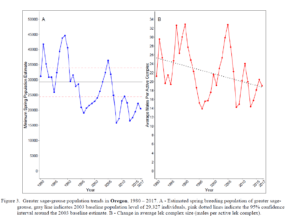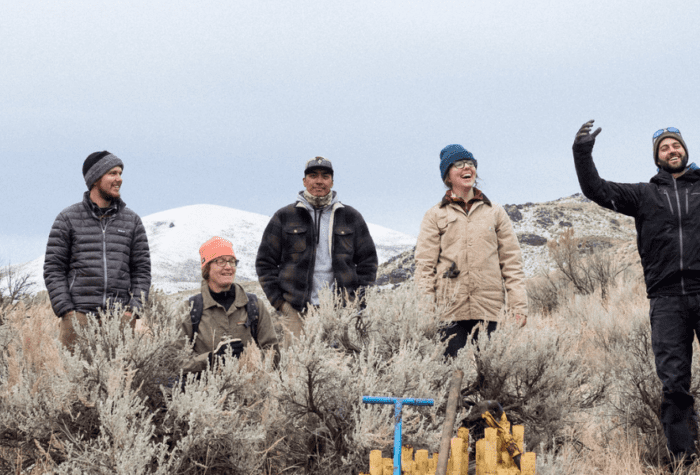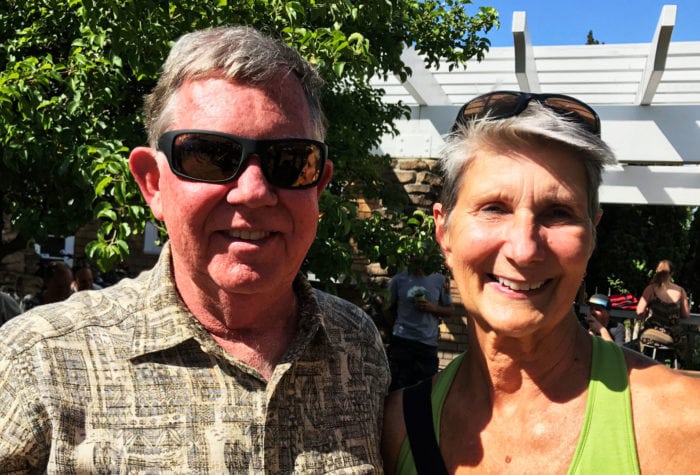A brief history
As many as 16 million of these iconic birds once ranged across nearly 300 million acres of sagebrush grasslands, an area of western North America so vast it is known as “the sagebrush sea.” Agriculture and development have reduced sage-grouse habitat by nearly half and sage-grouse populations have steadily declined in response.
- 2010: The U.S. Fish and Wildlife Service (USFWS) determined that the Greater sage-grouse warranted protection under the Endangered Species Act, a concerning alarm given that the sage-grouse is an “indicator species” for sagebrush habitat. If it’s not doing well, at least 350 other species dependent upon sagebrush habitat are also at risk.
- 2015: The Bureau of Land Management (BLM) unveiled a series of landscape-scale plans to protect the Greater sage-grouse and its habitat on public lands, including here in Oregon.
- 2017: The Trump Administration, led by Secretary of the Interior Ryan Zinke, directed a review of these sage-grouse plans that resulted in a series of short- and long-term recommendations that generally weaken or remove protections established in the 2015 plans.
The present situation
Oregon Department of Fish and Wildlife’s annual sage-grouse monitoring report for 2017 has again concluded that sage-grouse populations in Oregon have not stabilized, have not begun to recover, and are far from meeting population objectives.
As illustrated in the figure below, from ODFW’s report, the estimated spring 2017 Greater sage-grouse population of 20,510 individuals is a 7.7 percent decline from the population in 2016, and nearly 30 percent lower than the 2003 baseline population estimate of 29,237 individuals. Local populations of sage-grouse are also experiencing concerning decreases in populations and severe impacts to habitat from the effects of invasive species, wildfire and other land uses.

ONDA’s actions
More than a decade ago ONDA was among dozens of organizations that petitioned the USFWS to consider sage-grouse for listing under the Endangered Species Act. Since that time ONDA has been deeply involved in state and BLM planning processes for sage-grouse, including in-depth analyses and comments on the BLM plan that was finalized in 2015. We were also among the dozens of agencies, organizations and individuals that participated in the State of Oregon’s collaborative process for sage-grouse planning known as “SageCon.” ONDA continues to be a leading advocate for taking meaningful steps under the federal and state plans to protect and restore sage-grouse habitat and populations.
At this time, ONDA’s efforts are centered on ensuring that the BLM sage-grouse plan is not weakened by the Trump Administration so that effective conservation efforts can continue.
- ONDA led a coalition of Oregon conservation organizations that submitted detailed comments during the sage-grouse plan public comment period that closed on December 1.
- We have taken steps to defend the BLM plan in court by seeking to intervene in a suit filed by the Harney Soil and Water Conservation District (SWCD).
- We sought to intervene in a challenge against the plan’s closure of a limited number of research areas to livestock grazing.
An inspirational commitment by ONDA members
We’ve also asked for your help and involvement. More than 500 ONDA members and supporters provided detailed, personalized comments to BLM asking the agency to uphold meaningful protections for sage-grouse, and not to weaken its sage-grouse plan. For the past two seasons, ONDA volunteers monitored sage-grouse habitat in some of the most critical habitat areas in Oregon, in addition to our annual sage-grouse lek counts that help monitor populations. The commitment to sage-grouse by ONDA members is inspirational.
On the horizon
Our hope is that the strong input and years of effort by ONDA and our members will convince Secretary Zinke and BLM not to proceed with changes to the BLM plan. However, if the Trump Administration moves forward with its attempt to weaken sage-grouse protections, we are prepared to use every available avenue to ensure that sage-grouse conservation continues.
The USFWS is committed to reviewing the status of the species in 2020. If sage-grouse habitat and populations haven’t begun stabilizing by that time an endangered species act listing may be needed. Although we prefer the current stakeholder developed sage-grouse plans, we won’t hesitate to support a listing if it is the only means of recovering and protecting habitat and populations.
Taking action now
Here are the steps you can take now to support meaningful sage-grouse conservation.
Protecting this iconic desert species is within our reach. If we remain steadfast, we can protect the habitat that this bird needs in order to be able to sustain itself to sustain in the long-term, and, in so doing, protect an entire ecosystem and the array of benefits it provides for people who live in and visit Oregon’s high desert.


